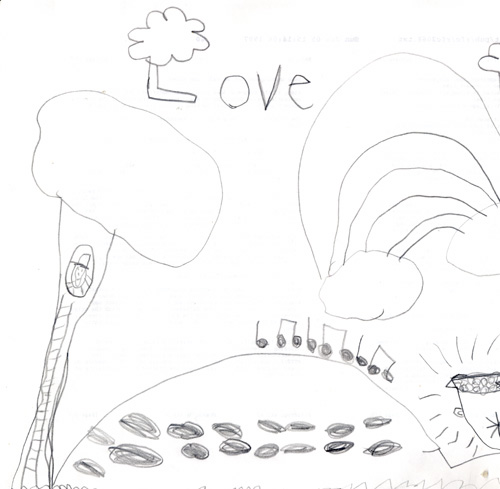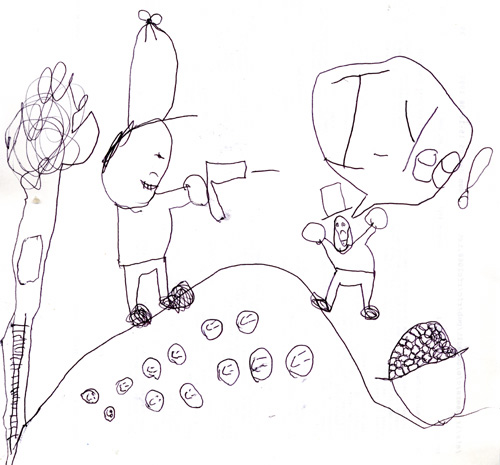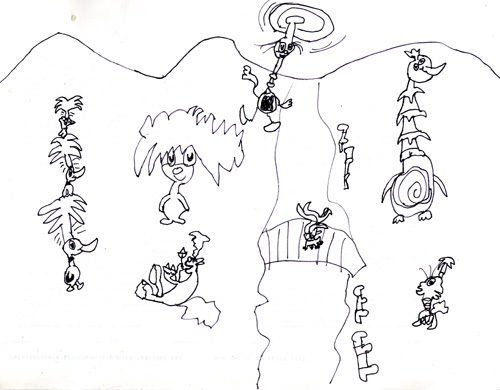At least in these parts, the March kindergarten homework packet is very leprechaun-centric. This raises some obvious questions about the status of leprechauns. Are they actual entities? Are they mythical? And how’s a curious kid to decide?

Younger offspring: I think leprechauns are real, even though I’ve never seen one. There are lots of stories about leprechauns.* Maybe if we went to Ireland we could find leprechauns — I don’t think they would live in California.
Elder offspring: I don’t think leprechauns are real.
Dr. Free-Ride: Why not?
Elder offspring: I think you told me they were mythical.
Dr. Free-Ride: Did I say that? It sounds like a much stronger commitment than I usually make on matters like this.
Elder offspring: Well, I’ve never seen a leprechaun, so I don’t think they could be real.
Dr. Free-Ride’s better half: Are wombats real?
Elder offspring: Of course they are!
Dr. Free-Ride better half: But you’ve never actually seen a wombat.
Elder offspring: I’ve seen them in books.
Dr. Free-Ride: But I know we have books with leprechauns in them, too.
Elder offspring: Those books mostly say leprechauns are legends, though.
Dr. Free-Ride: Do you think that just because something is in a book you can believe it? What about the stuff in that giant squid book?
Elder offspring: OK, some books are not trustworthy.
A discussion ensued about methods that might be used to determine whether leprechauns exist. Trying to actually catch a leprechaun seemed like it might yield the most detailed information (at least, if we succeeded). It was decided that it would be more humane to pursue this end with a leprechaun trap than with the Elmer Fudd-like hunter pictured below.

That the sprogs have different views about where it is proper to place the burden of proof — the younger Free-Ride offspring is inclined to believe in leprechauns until presented with evidence that positively proves their nonexistence, while the elder Free-Ride offspring thinks the onus is on leprechaun-believers to produce a leprechaun as proof — is not surprising.
What is surprising is the elder Free-Ride offspring’s view on Pokemon, which is that they do exist but have not yet been captured or observed by humans. How it is that critters that have not yet been observed by humans are so well characterized is an issue the elder Free-Ride offspring still has not explained to my satisfaction. Possibly Pokemon are theoretical critters whose characteristics have been specified in advance of their empirical grounding?
Really, it’s just one more thing I don’t understand about Pokemon.

Critters in the style of Dr. Seuss — mythical, theoretical, actual?
_____
* The sprogs highly recommend a CD of such stories, Sharon Kennedy’s Irish Folk Tales for Children. You are warned that repeated listening may leave you or your children with a brogue.

I’m surprised that the Elder Offspring believes that trout are real after our last fishing trip. If she believes they are real.
To borrow from you, Janet, one may ask whether the burden of proof of Intelligent Design is on those who believe in it or on the evolutionists who argue against it?
Uncle Fishy – I bet you made the mistake of fishing for trout in a river. Try fishing in a supermarket next time: after extensive observation, it’s clear to me that this is their natural habitat.
The only thing you’ll catch in river is a discarded brogue.
Bob
“… it’s just one more thing I don’t understand about Pokemon…”
In my empirical research on the Pokemon phenomena, when my little boy was a somewhat obsessed expert on their “evolution” and characteristics, I went so far as to learn the card game and eneter a tournement where he was playing.
I was wiped out in the first round every time by knee-high girls and boys.
I still don’t get it, but I don’t question their intelligence…
I am continually amazed by your talent at writing, storytelling, and general level of sophistication. Also, your kids rock!
Thank you so much for sharing these parenting snippets with us, and for demonstrating how easy it is to teach kids the scientific method from the youngest age.
Ah, tis a fine day for readin’ your blog, and as long as the wee ones don’t start wantin’ to be sipping a bit ‘o the Jameson’s I think you are okay!
Ahh, but the real question is do any Pokemon know any leprechaun’s? or wombats? or unicorns?
You may have already seen this, but if not you’ll find this paper interesting:
Skolnick & Bloom (2006). What does Batman think about Spongebob: Children’s understanding of the fantasy/fantasy distinction. Cognition, 101.
http://www.yale.edu/langcoglab/papers/skolnick&bloom%20cognition.pdf
I heard a comedian (I go to a lot of stand-up comedy shows, as I am a first cousin to stand-up superstar Rich Vos and have friends who do stand-up):
“Does Santa Claus believe in the Easter Bunny? And does he personally know my Guardian Angel?”
The audience roars with laughter. Is that because they remember their own childhood uncertainty as to such belief structures?
There is a small but fascinating subgenre of Fantasy literature than presumes the reality of fictional characters, and allows the narrator to converse with them. This happened in Vol 2 of Don Quixote, and many times since, including Heinlein’s “The Number of the Beast,” L. Ron Hubbard’s “Typewriter in the Sky”, the recent film “Stranger Than Fiction,” starring Will Ferrell and Emma Thompson (which didn’t think things through as deeply as these other citations) and the amazing “Silverlock”, published in 1949, by John Myers Myers.
As wikipedia summarizes:
This novel follows A. Clarence Shandon, who is plucked from a life of gloom into an adventurous journey through the “Commonwealth of Letters”, an allegorical land of major literature. Golias, his guide is a man well versed in this land. He seems almost to be each of the great storytellers of the fictional world embodied in a single person.
Silverlock follows A. Clarence Shandon, a bored thirty-something with a BA in business administration from Chicago who is stuck in a dead-end existence. While on a seavoyage his ship founders and he is washed ashore in the mystical land known only as “The Commonwealth”.
Shandon is referred to as “Silverlock” by his guide, Golias. The real experience of the story and thus “Silverlock” is trying to identify the places and characters in the book, since they are all from other works of literature or mythology.
“In this richly picaresque story of a modern man’s fruitful adventurings in legendary realms of gold, John Myers Myers has presented a glowing tapestry of real excitement and meaning. In essence, this is the tale of Silverlock’s wanderings in the Commonwealth, the land of immortal heroes real and imagined, in search of his true destiny. In form, it is sheer headlong narrative, with occasional clangorous verses woven into its fabric. In content, it is something between a many-peopled, incident-studded story of high emprise, and a morality for our time. Always it is fresh and bold in concept, superb in its execution . . . How A. Clarence Shandon came to the Commonwealth, exchanging his everyday name and Chicago-bound life for that of a traveler beyond time; what great ones of old legend and modern story he encountered, and to what purpose; what loves he knew and what fights he fought; what trials befell him in the Pit, and what truth he discovered when at last he won to the Hippocrene Spring — these are matters of such crowding variety and implicit significance as the reader must discover for himself . . . And in the discovering, the literate reader will have a wonderful time. He will be amused by the wicked wit that illumines the vast panorama, and intrigued by the challenge it offers his own learning. Most of all, he will be impressed by its profound knowledge, of our cultural heritage, and stirred by its vital interpretations.”–From first edition the dust jacket